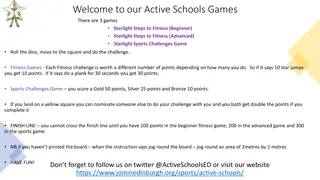Principles of Training and Normative Data in Fitness
Explore the essential principles of training, progress indicators, and the purpose of normative data in fitness assessments. Learn how normative data from a general population can help gauge your own fitness levels. Discover fitness tests like the Sit-Up Test and Press-Up Test and how you can use normative data to compare your results. Improve your fitness components and performance by analyzing your tests and identifying areas for enhancement.
Download Presentation

Please find below an Image/Link to download the presentation.
The content on the website is provided AS IS for your information and personal use only. It may not be sold, licensed, or shared on other websites without obtaining consent from the author.If you encounter any issues during the download, it is possible that the publisher has removed the file from their server.
You are allowed to download the files provided on this website for personal or commercial use, subject to the condition that they are used lawfully. All files are the property of their respective owners.
The content on the website is provided AS IS for your information and personal use only. It may not be sold, licensed, or shared on other websites without obtaining consent from the author.
E N D
Presentation Transcript
Principles of training & Normative data DNA On whiteboard - List and discuss what you can remember about principles of training Progress Indicators Good Outstanding Be able to explain the purpose of normative data and state 4 principles of training Link a principle of training to a sporting example (of it being used effectively) 1
Make an acronym . Cardiovascular fitness (aerobic endurance) Strength Muscular endurance Flexibility Body composition Agility Balance Coordination Power Reaction time Speed 2
What is Normative data ? Discuss, 2 minutes 3
Normative Data Normative data is data from a population that gives a range of measurements in an area that can be used for a comparison. This data is taken from a randomly selected general population. In normal speak . It can gives a set of fitness test results you can compare your own with to see what level you are at! 4
Sit Up Test Press Up Test Ruler drop test 5
Your turn! 1. Chose two of the available fitness tests 2. Do them both 3. Write your result in your book 4. Use www.brianmac.co.uk to make a normative data comparison of your results 5. Write down what normative data category for your age group you were in for each test 6
How can we improve these fitness components? Will improving these fitness components improve performance? 7
Answer each question for each result What test have you completed 1. 2. What component of fitness is it testing 3. What was your score 4. What normative data category are you in 5. What does this mean in terms of this fitness component 6. How far away (in measurement) are you from the next category up on this test 7. What method of training would improve this component of fitness (last year!) 8
S PO O R T I Principles of Training F I T T SPORTI
The most valuable part is the how can it be used section Using the text books or PC s research the principles of training and explain how they can be applied in training 12
Demonstrate Question: Discuss, using examples, how the principles of training can improve the fitness of a group of GCSE PE students. (6) ___/ 6
1-2 ? 3-4 5-6 ? ?
Frequency Intensity Time Type Specificity Progressive Overload Overtraining Reversibility Threshold Training Individual needs Anaerobic = 80-90% Aerobic = 60-80% This will become clearer later but so you get used to remembering this So what are the principles of training THINK SPORTI
Help Cardiovascular Endurance: Spinning Muscular endurance: Weight/resistance training Body Pump Aerobics Circuit training Interval training Body Pump Spinning Fartlek training Continuous training Circuit training Speed Flexibility: Interval training Flexibility training Weight/resistance training Yoga / pilates Power: Muscular strength: Interval training Weight/resistance training Weight/resistance training Body Pump Plyometric training
Connect Identify all the Principles of training Detail of how each PoT will be applied in a PEP to improve Muscular Strength Give simple examples of how most the PoT will help improve fitness Give a definition of each Challenge Describe how this would be different for a 21 year old male athlete trying to improve his strength and a 40 year old female who wants to improve her cardiovascular fitness























